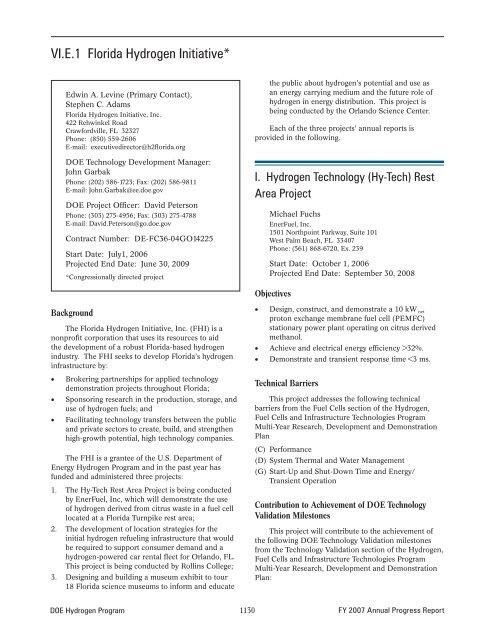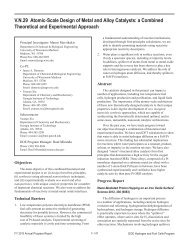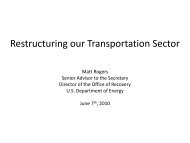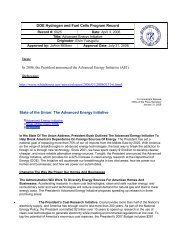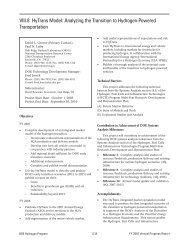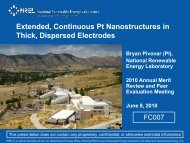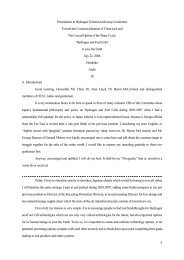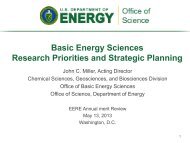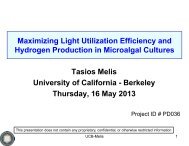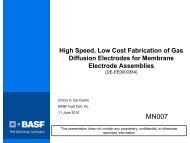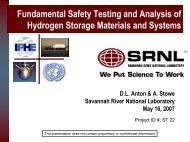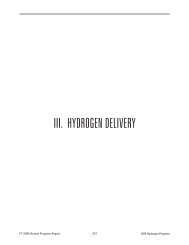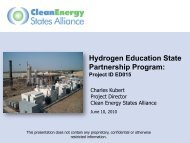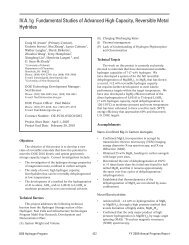PDF 455 KB - DOE Hydrogen and Fuel Cells Program Home Page
PDF 455 KB - DOE Hydrogen and Fuel Cells Program Home Page
PDF 455 KB - DOE Hydrogen and Fuel Cells Program Home Page
You also want an ePaper? Increase the reach of your titles
YUMPU automatically turns print PDFs into web optimized ePapers that Google loves.
VI.E.1 Florida <strong>Hydrogen</strong> Initiative*<br />
Edwin A. Levine (Primary Contact),<br />
Stephen C. Adams<br />
Florida <strong>Hydrogen</strong> Initiative, Inc.<br />
422 Rehwinkel Road<br />
Crawfordville, FL 32327<br />
Phone: (850) 559-2606<br />
E-mail: executivedirector@h2florida.org<br />
<strong>DOE</strong> Technology Development Manager:<br />
John Garbak<br />
Phone: (202) 586-1723; Fax: (202) 586-9811<br />
E-mail: John.Garbak@ee.doe.gov<br />
<strong>DOE</strong> Project Officer: David Peterson<br />
Phone: (303) 275-4956; Fax: (303) 275-4788<br />
E-mail: David.Peterson@go.doe.gov<br />
Contract Number: DE-FC36-04GO14225<br />
Start Date: July1, 2006<br />
Projected End Date: June 30, 2009<br />
*Congressionally directed project<br />
the public about hydrogen’s potential <strong>and</strong> use as<br />
an energy carrying medium <strong>and</strong> the future role of<br />
hydrogen in energy distribution. This project is<br />
being conducted by the Orl<strong>and</strong>o Science Center.<br />
Each of the three projects’ annual reports is<br />
provided in the following.<br />
I. <strong>Hydrogen</strong> Technology (Hy-Tech) Rest<br />
Area Project<br />
Michael Fuchs<br />
Ener<strong>Fuel</strong>, Inc.<br />
1501 Northpoint Parkway, Suite 101<br />
West Palm Beach, FL 33407<br />
Phone: (561) 868-6720, Ex. 239<br />
Start Date: October 1, 2006<br />
Projected End Date: September 30, 2008<br />
Objectives<br />
Background<br />
The Florida <strong>Hydrogen</strong> Initiative, Inc. (FHI) is a<br />
nonprofit corporation that uses its resources to aid<br />
the development of a robust Florida-based hydrogen<br />
industry. The FHI seeks to develop Florida’s hydrogen<br />
infrastructure by:<br />
• Brokering partnerships for applied technology<br />
demonstration projects throughout Florida;<br />
• Sponsoring research in the production, storage, <strong>and</strong><br />
use of hydrogen fuels; <strong>and</strong><br />
• Facilitating technology transfers between the public<br />
<strong>and</strong> private sectors to create, build, <strong>and</strong> strengthen<br />
high-growth potential, high technology companies.<br />
The FHI is a grantee of the U.S. Department of<br />
Energy <strong>Hydrogen</strong> <strong>Program</strong> <strong>and</strong> in the past year has<br />
funded <strong>and</strong> administered three projects:<br />
1. The Hy-Tech Rest Area Project is being conducted<br />
by Ener<strong>Fuel</strong>, Inc, which will demonstrate the use<br />
of hydrogen derived from citrus waste in a fuel cell<br />
located at a Florida Turnpike rest area;<br />
2. The development of location strategies for the<br />
initial hydrogen refueling infrastructure that would<br />
be required to support consumer dem<strong>and</strong> <strong>and</strong> a<br />
hydrogen-powered car rental fleet for Orl<strong>and</strong>o, FL.<br />
This project is being conducted by Rollins College;<br />
3. Designing <strong>and</strong> building a museum exhibit to tour<br />
18 Florida science museums to inform <strong>and</strong> educate<br />
• Design, construct, <strong>and</strong> demonstrate a 10 kW net<br />
proton exchange membrane fuel cell (PEMFC)<br />
stationary power plant operating on citrus derived<br />
methanol.<br />
• Achieve <strong>and</strong> electrical energy efficiency >32%.<br />
• Demonstrate <strong>and</strong> transient response time
Levine – Florida <strong>Hydrogen</strong> Initiative, Inc.<br />
VI.E Technology Validation / Cross-Cutting<br />
• Milestone 35: Validate $1.60/gge hydrogen<br />
cost from biomass <strong>and</strong> $3.10/kg for renewable/<br />
electrolysis at the plant gate. The project will<br />
assess the sources <strong>and</strong> economics of bio-derived<br />
methanol in Florida.<br />
survey of the electrical interface requirements was<br />
begun. Ener<strong>Fuel</strong> completed the trade study to compare<br />
the attributes of DMFC or IMFC approaches <strong>and</strong><br />
determined that an indirect methanol fuel cell is the best<br />
alternative for achieving the project’s goals (Table 1).<br />
Accomplishments<br />
• Completed direct methanol fuel cell (DMFC) vs.<br />
indirect methanol fuel cell (IMFC) trade study.<br />
• Selected fuel cell system demonstration site.<br />
Introduction<br />
G G G G G<br />
One of Florida’s most important agriculturalbased<br />
industries is citrus <strong>and</strong> using citrus waste as a<br />
source of fuel for the generation of electrical power<br />
would be a significant benefit to the environment <strong>and</strong><br />
provide an additional feedstock for fuel cell H 2<br />
. The<br />
Ener<strong>Fuel</strong> project will determine the effects of citrus<br />
derived methanol on long-term fuel cell power plant<br />
performance <strong>and</strong> assess requirements for future projects<br />
<strong>and</strong> commercialization. By designing, constructing, <strong>and</strong><br />
operating a 10 kW net<br />
stationary fuel cell power plant<br />
at the Florida Turnpike’s Turkey Lake Service Plaza to<br />
provide electrical power to the rest facilities, the project<br />
will demonstrate the value of the citrus waste as a viable<br />
source of fuel for the generation of electrical power.<br />
Approach<br />
Ener<strong>Fuel</strong> is identifying sources of citrus<br />
derived methanol, designing <strong>and</strong> demonstrating its<br />
transportation <strong>and</strong> storage, <strong>and</strong> the safety protocols<br />
required for the use of citrus derived methanol. They<br />
will obtain all of the required permits <strong>and</strong> prepare the<br />
demonstration site for power plant installation, including<br />
the electrical interface <strong>and</strong> methanol storage. They will<br />
design, construct, test <strong>and</strong> benchmark the fuel cell power<br />
plant <strong>and</strong> install <strong>and</strong> operate it at the Florida Turnpike<br />
Turkey Lake Service Plaza. The analysis of the fuel cell<br />
power plant under operation will determine the overall<br />
electrical efficiency, document system transient response<br />
to load changes, determine the effects of citrus derived<br />
methanol on long-term power plant performance, <strong>and</strong><br />
assess requirements for future commercialization.<br />
Results<br />
The project selected the demonstration site <strong>and</strong><br />
secured the approval <strong>and</strong> support of the Florida<br />
Turnpike Authority for the fuel cell power plant to<br />
provide the electrical power for the rest area facility.<br />
The locations of the power plant <strong>and</strong> the methanol<br />
storage container were tentatively selected <strong>and</strong> the<br />
Table 1. DMFC vs. IMFC Trade Study Results<br />
Performance<br />
Criteria<br />
Overall<br />
System Cost<br />
DMFC IMFC Basis<br />
X 10 kW DMFC system is ~579%<br />
more expensive than IMFC system<br />
Stack Cost X DMFC stack is an order of<br />
magnitude more expensive than an<br />
equivalent H-PEMFC stack<br />
Stack Size X 10 kW DMFC stack will contain<br />
~3 times as many cells as an<br />
equivalent H-PEMFC stack<br />
System<br />
Complexity<br />
Overall<br />
System<br />
Efficiency<br />
Energy<br />
Density<br />
X DMFC system has nine major<br />
components. IMFC has at least 13<br />
X<br />
X<br />
IMFC overall system efficiency is<br />
~30%. DMFC is ~20%<br />
Methanol/water tank is major<br />
contributor to lower DMFC power<br />
density. DMFC fuel tank is ~20<br />
times larger than for an IMFC<br />
system with same energy storage<br />
Emissions X Both systems are susceptible to<br />
emitting trace methanol amounts.<br />
Nonetheless, lower DMFC overall<br />
system efficiency means greater<br />
CO 2<br />
emissions will be released<br />
from the DMFC system. Therefore,<br />
in this category IMFCs performed<br />
better<br />
Conclusions <strong>and</strong> Future Directions<br />
• The project has selected the technical approach<br />
for using citrus waste derived methanol for the fuel<br />
cell power plant <strong>and</strong> has selected a function <strong>and</strong><br />
location for the power plant.<br />
• In the coming year Ener<strong>Fuel</strong> will design, build,<br />
deliver <strong>and</strong> install the fuel cell power plant <strong>and</strong><br />
analyze it under operation at the Turkey Lake<br />
Service Plaza.<br />
II. Location Strategies for the Initial<br />
<strong>Hydrogen</strong> Refueling Infrastructure in<br />
Florida<br />
Lee Lines (Primary Contact), Rollins College;<br />
Michael Kuby, Arizona State University<br />
Department of Environmental Studies, Rollins College<br />
FY 2007 Annual Progress Report<br />
1131<br />
<strong>DOE</strong> <strong>Hydrogen</strong> <strong>Program</strong>
VI.E Technology Validation / Cross-Cutting<br />
Levine – Florida <strong>Hydrogen</strong> Initiative, Inc.<br />
1000 Holt Avenue<br />
Winter Park, FL 32789<br />
Phone: (407) 628-6377<br />
E-mail: llines@Rollins.edu<br />
Start Date: January 1, 2006<br />
Projected End date: June 30, 2007<br />
Objectives<br />
• Develop a model for optimal location of a system<br />
for hydrogen refueling stations.<br />
• Use the model to recommend location strategies for<br />
refueling stations at two scales: statewide network<br />
<strong>and</strong> Orl<strong>and</strong>o network.<br />
• Investigate the feasibility of a hydrogen rental car<br />
business based at the Orl<strong>and</strong>o International Airport.<br />
Technical Barriers<br />
This project addresses the following technical<br />
barrier from the <strong>Hydrogen</strong> Delivery section of the<br />
<strong>Hydrogen</strong>, <strong>Fuel</strong> <strong>Cells</strong> <strong>and</strong> Infrastructure Technologies<br />
<strong>Program</strong> Multi-Year Research, Development <strong>and</strong><br />
Demonstration Plan:<br />
(A) Lack of <strong>Hydrogen</strong>/Carrier <strong>and</strong> Infrastructure<br />
Options Analysis<br />
Contribution to the Achievement of <strong>DOE</strong> <strong>Hydrogen</strong><br />
Delivery Milestones<br />
This project will contribute to the achievement of<br />
the following <strong>DOE</strong> <strong>Hydrogen</strong> Delivery milestones from<br />
the <strong>Hydrogen</strong> Delivery section of the <strong>Hydrogen</strong>, <strong>Fuel</strong><br />
<strong>Cells</strong> <strong>and</strong> Infrastructure Technologies <strong>Program</strong> Multi-<br />
Year Research, Development <strong>and</strong> Demonstration Plan:<br />
• Milestone 2: Identify cost-effective options for<br />
hydrogen delivery infrastructure to support the<br />
introduction <strong>and</strong> long-term use of hydrogen<br />
for transportation <strong>and</strong> stationary power. (4Q<br />
2007) The development <strong>and</strong> use of the model will<br />
support the cost-effective <strong>and</strong> timely location of<br />
hydrogen refueling stations in the Orl<strong>and</strong>o area <strong>and</strong><br />
the development of the entire statewide refueling<br />
systems network.<br />
Accomplishments<br />
• Developed software <strong>and</strong> databases.<br />
• Ran models under several scenarios <strong>and</strong> at different<br />
scales.<br />
• Surveyed car renters <strong>and</strong> interviewed key people in<br />
rental <strong>and</strong> hydrogen industries.<br />
• Wrote <strong>and</strong> submitted Report #1 on Optimal<br />
Refueling Infrastructure Strategies.<br />
• Wrote <strong>and</strong> submitted Report #2 on Feasibility of<br />
<strong>Hydrogen</strong> Rental Car Business.<br />
Introduction<br />
G G G G G<br />
The location of hydrogen refueling stations is a nontrivial<br />
problem as the costs of each station are significant<br />
<strong>and</strong> the number of hydrogen-fueled internal combustion<br />
engines (ICE) <strong>and</strong> fuel cell vehicles (FCV) is currently<br />
small. A barrier to consumer purchases of hydrogen fuel<br />
cell vehicles is the availability of refueling stations <strong>and</strong><br />
the limited range of current FCVs. Determining where<br />
the refueling stations should be located to maximize the<br />
number of trips that can be refueled given a reasonable<br />
driving range will greatly assist the adoption of FCVs by<br />
reducing consumer concerns about the availability of H 2<br />
<strong>and</strong> increase the probability that investors will be willing<br />
to provide <strong>and</strong> operate refueling stations. The project<br />
developed models for the optimal location of a system<br />
of hydrogen refueling stations for the Orl<strong>and</strong>o area <strong>and</strong><br />
for a statewide network. Orl<strong>and</strong>o, Florida, is the hub of<br />
a major tourist industry <strong>and</strong> a FCV car rental business,<br />
located at the Orl<strong>and</strong>o International Airport, could be<br />
supported by a small number of refueling stations. A<br />
2006 NREL study of barriers found that the fleet market<br />
is “not sufficient to generate sufficient sales for vehicle<br />
manufacturers,” <strong>and</strong> concluded that “finding a way to<br />
transition from fleets to consumers is equally critical.” A<br />
hydrogen rental car fleet could be ideal for this purpose.<br />
Approach<br />
The project team built models using operations<br />
research <strong>and</strong> geographic information system (GIS) data.<br />
The model did not assume or hard wire clustering/<br />
connecting, but those strategies did emerge from the<br />
models. The model assumes that drivers “stop along their<br />
way” to refuel, thus trips consist of the shortest path, in<br />
minutes, through the network from every origin to every<br />
destination. For Orl<strong>and</strong>o this resulted in a 102x102<br />
matrix of flows. The project team surveyed 435 car<br />
renters at the Orl<strong>and</strong>o International Airport to determine<br />
where they were going <strong>and</strong> to identify any concerns<br />
they might have about renting a FCV, including safety,<br />
willingness to detour for refueling, <strong>and</strong> how much more<br />
they would be willing to pay to rent a FCV. Interviews<br />
were also conducted with key people in the car rental<br />
<strong>and</strong> hydrogen industries to determine their perceived<br />
barriers <strong>and</strong> solutions to the timely adoption of FCVs.<br />
Results<br />
The survey data determined that four refueling<br />
stations could serve 85% of the visiting car renters’<br />
trips: Orl<strong>and</strong>o International Airport, Disney World,<br />
<strong>DOE</strong> <strong>Hydrogen</strong> <strong>Program</strong><br />
1132<br />
FY 2007 Annual Progress Report
Levine – Florida <strong>Hydrogen</strong> Initiative, Inc.<br />
VI.E Technology Validation / Cross-Cutting<br />
Downtown Orl<strong>and</strong>o, <strong>and</strong> the Kennedy Space Center.<br />
The Orl<strong>and</strong>o model <strong>and</strong> analysis showed that locating<br />
refueling stations at funnel points on the road network,<br />
will capture trips from many origins to many destinations<br />
while not str<strong>and</strong>ing assets at other locations. Locating<br />
the first 10–15 refueling stations on freeways would be<br />
followed by locating stations at smaller funnel points in<br />
suburban areas. The results also showed that spreading<br />
stations evenly across the region is not cost-effective for<br />
capturing trips. Ten stations, located in accordance with<br />
the model, could intercept 53% of Orl<strong>and</strong>o trips (Figure<br />
1). The statewide analysis suggests a strategy similar<br />
to that being developed in California, beginning with<br />
clusters of refueling stations in the major cities, followed<br />
by bridging stations between them to facilitate inter-city<br />
trips. The first two clusters should be in the I-4 corridor<br />
from Tampa to Orl<strong>and</strong>o (including stations for rental car<br />
customers) <strong>and</strong> the Miami-West Palm Beach corridor.<br />
Conclusions <strong>and</strong> Future Directions<br />
• The modeling showed that the key assumption for<br />
locating refueling stations is to maximize trips or<br />
vehicle miles traveled with the given number of<br />
stations <strong>and</strong> the range for the fuel cell vehicle.<br />
• To build the Florida infrastructure’s network of<br />
stations, clusters should be built in Miami–Palm<br />
Beach <strong>and</strong> Tampa–Orl<strong>and</strong>o before connecting<br />
clusters.<br />
• For the Orl<strong>and</strong>o infrastructure, key freeway <strong>and</strong><br />
arterial junctions should be the sites for the first<br />
10–15 stations.<br />
• The renter survey found that a refueling station at<br />
the Orl<strong>and</strong>o International Airport, <strong>and</strong> three other<br />
stations, could serve 85% of the renters.<br />
• Orl<strong>and</strong>o is an ideal location for the first hydrogen<br />
fuel cell rental car business.<br />
Percent of trips refueled<br />
90%<br />
80%<br />
70%<br />
60%<br />
50%<br />
40%<br />
30%<br />
20%<br />
10%<br />
0%<br />
0<br />
Existing Airport Station<br />
5 10 15 20 25<br />
Number of Stations<br />
Figure 1. Tradeoff Between the Number of Refueling Stations <strong>and</strong><br />
Percentage of Trips Intercepted for the Orl<strong>and</strong>o Region<br />
• Benefits would be felt nationally as tourists renting<br />
FCVs could generate publicity <strong>and</strong> attention.<br />
• The rental of a FCV would allow interested<br />
members of the public to “test drive” the vehicle<br />
with low financial risks while the car rental agency<br />
assumes the responsibility for maintenance, initial<br />
training, <strong>and</strong> capital costs.<br />
• A hydrogen rental car fleet would be an ideal<br />
way to transition from fleets to consumers, as<br />
recommended by NREL [1].<br />
• Based on positive attitudes expressed in car renters’<br />
survey data, planning for a FCV car rental business<br />
could begin now.<br />
FY 2007 Publications/Presentations<br />
1. Location Strategies for the Initial <strong>Hydrogen</strong> Refueling<br />
Infrastructure in Florida, Michael Kuby, Lee Lines, Ron<br />
Schultz, Zhixiao Xie, Seow Lim, Jong-Guen Kim, <strong>and</strong><br />
James Clancy. 2007 NHA Conference, San Antonio,<br />
Texas. Submitted to Proceedings of the National <strong>Hydrogen</strong><br />
Association (April 11, 2007).<br />
References<br />
1. M.Melendez. “Transitioning to a <strong>Hydrogen</strong> Future:<br />
Learning from the Alternative <strong>Fuel</strong>s Experience,” National<br />
Renewable Energy Laboratory. Technical Report No.<br />
NREL/TP-540-39423 (2206).<br />
III. Assessment of Public Underst<strong>and</strong>ing<br />
of the <strong>Hydrogen</strong> Economy Through<br />
Science<br />
Brian Tonner<br />
Orl<strong>and</strong>o Science Museum<br />
777 East Princeton Street<br />
Orl<strong>and</strong>o, FL 32803<br />
Phone: (407) 514-2011<br />
E-mail: Btonner@osc.org<br />
Start Date: July 31, 2006<br />
Projected End Date: September 30, 2008<br />
Objectives<br />
• Design, build, <strong>and</strong> tour a museum quality interactive<br />
hydrogen exhibit <strong>and</strong> “HydroPedia” based on<br />
survey assessments of current public <strong>and</strong> key target<br />
audiences’ underst<strong>and</strong>ing of hydrogen science <strong>and</strong><br />
engineering.<br />
• Increase public underst<strong>and</strong>ing of hydrogen science<br />
<strong>and</strong> engineering.<br />
FY 2007 Annual Progress Report<br />
1133<br />
<strong>DOE</strong> <strong>Hydrogen</strong> <strong>Program</strong>
VI.E Technology Validation / Cross-Cutting<br />
Levine – Florida <strong>Hydrogen</strong> Initiative, Inc.<br />
Technical Barriers<br />
This project addresses the following technical barriers<br />
from the Education section of the <strong>Hydrogen</strong>, <strong>Fuel</strong> <strong>Cells</strong><br />
<strong>and</strong> Infrastructure Technologies <strong>Program</strong> Multi-Year<br />
Research, Development <strong>and</strong> Demonstration Plan:<br />
(A) Lack of Readily Available, Objective, <strong>and</strong><br />
Technically Accurate Information<br />
(B) Mixed Messages<br />
(C) Disconnect Between <strong>Hydrogen</strong> Information <strong>and</strong><br />
Dissemination Networks<br />
(E) Regional Differences<br />
Contribution to Achievement of <strong>DOE</strong> Education<br />
Milestones<br />
This project will contribute to the achievement<br />
of the following <strong>DOE</strong> Education milestones from<br />
the Education section of the <strong>Hydrogen</strong>, <strong>Fuel</strong> <strong>Cells</strong><br />
<strong>and</strong> Infrastructure Technologies <strong>Program</strong> Multi-Year<br />
Research, Development <strong>and</strong> Demonstration Plan:<br />
• Milestone 11: Develop set of introductory<br />
materials suitable for a non-technical audience.<br />
(4Q 2006) The interactive exhibit, “HydroPedia”,<br />
<strong>and</strong> “H2NOW” website are designed for nontechnical<br />
audiences <strong>and</strong> will be exhibited in Orl<strong>and</strong>o<br />
<strong>and</strong> at 16 regional <strong>and</strong> national science museums<br />
<strong>and</strong> centers.<br />
• Milestone 32: Evaluate knowledge <strong>and</strong> opinion<br />
of key target audiences <strong>and</strong> progress toward<br />
meeting objectives. (4Q 2009) The project has<br />
completed preliminary survey of Florida teachers,<br />
school children, <strong>and</strong> home-school families to<br />
determine content knowledge <strong>and</strong> attitudes towards<br />
alternative energy with embedded questions related<br />
to hydrogen as a fuel <strong>and</strong> will conduct additional<br />
surveys throughout the project lifetime.<br />
Accomplishments<br />
• Assessed public underst<strong>and</strong>ing of energy issues in<br />
general <strong>and</strong> hydrogen in particular.<br />
• Determined affective <strong>and</strong> objective learning goals of<br />
the exhibition.<br />
• Completed first stage selection of interactive <strong>and</strong><br />
display elements of the exhibition.<br />
• Completed two design charettes to determine story<br />
content of the exhibit <strong>and</strong> down-select from three<br />
story concepts to a single best concept.<br />
• Completed first stage selection of technology,<br />
displays, <strong>and</strong> interactives.<br />
• Designed data gathering interactives <strong>and</strong> tested<br />
two prototypes of electronic survey tools in actual<br />
audience response settings.<br />
Introduction<br />
G G G G G<br />
Increasing knowledge <strong>and</strong> awareness levels<br />
of hydrogen <strong>and</strong> fuel cells <strong>and</strong> correcting common<br />
misunderst<strong>and</strong>ings of hydrogen’s properties in order<br />
to create positive opinions about the safe use of<br />
hydrogen as an energy carrier are essential to the widespread<br />
adoption <strong>and</strong> commercialization of hydrogen.<br />
Translating scientific <strong>and</strong> engineering concepts into<br />
a publicly accessible format that can be viewed <strong>and</strong><br />
accessed in an interesting <strong>and</strong> interactive manner is a<br />
challenging <strong>and</strong> import task.<br />
Approach<br />
Working with I.d.e.a.s. at Disney MGM Studios, the<br />
Orl<strong>and</strong>o Science Museum (OSM) is designing, building,<br />
<strong>and</strong> preparing a touring exposition that will be installed<br />
initially at the OSM <strong>and</strong> then tour at 16 regional <strong>and</strong><br />
national museums. In addition to the touring expo,<br />
a “wiki” style web resource for hydrogen education,<br />
“H2NOW” a web portal that will be a clearinghouse<br />
for the exhibit <strong>and</strong> events, <strong>and</strong> a “Hydropedia” that<br />
will be an on-line forum for information <strong>and</strong> dialog will<br />
be established. The “curriculum” of the expo <strong>and</strong> the<br />
on-line resources will be based on the results of surveys<br />
of key target audiences, including teachers, school-aged<br />
children, <strong>and</strong> home-schooling families.<br />
Results<br />
Completed first stage design of the touring hydrogen<br />
exposition, working with I.d.e.a.s. at Disney MGM<br />
Studios <strong>and</strong> the web site design for the “Hydropedia”.<br />
Completed the first set of surveys of target audiences<br />
- teachers, school children, <strong>and</strong> home-schooling families<br />
- to determine their baseline knowledge. Determined<br />
the affective <strong>and</strong> objective learning goals of the<br />
exhibit. Potential interactives were identified, based<br />
on consultation with Florida Solar Energy Center<br />
personnel, Orl<strong>and</strong>o Science Center staff, <strong>and</strong> the science<br />
center industry. The first stage selection of interactives<br />
display elements of the exhibition was completed.<br />
Prototyped exhibit elements <strong>and</strong> determined the state<br />
of the art for interactive hydrogen <strong>and</strong> alternative<br />
energy exhibits in order to develop a list of potential<br />
off-the-shelf components that that can be purchased or<br />
adapted from existing designs. Designed data gathering<br />
interactives <strong>and</strong> tested two prototypes of electronic<br />
survey tools in actual audience response settings.<br />
<strong>DOE</strong> <strong>Hydrogen</strong> <strong>Program</strong><br />
1134<br />
FY 2007 Annual Progress Report
Levine – Florida <strong>Hydrogen</strong> Initiative, Inc.<br />
VI.E Technology Validation / Cross-Cutting<br />
Conclusions <strong>and</strong> Future Directions<br />
• The Orl<strong>and</strong>o Science Museum will fabricate the<br />
exhibit <strong>and</strong> following its installation in Orl<strong>and</strong>o,<br />
will manage its touring at 16 regional <strong>and</strong> national<br />
museums.<br />
• The content <strong>and</strong> presentation of the exhibition <strong>and</strong><br />
the web resources will be reviewed by science <strong>and</strong><br />
museum experts, such as the Florida Solar Energy<br />
Center.<br />
• As an on-going activity, additional surveys of target<br />
audiences will be refined <strong>and</strong> exp<strong>and</strong>ed throughout<br />
the project lifetime.<br />
FY 2007 Annual Progress Report<br />
1135<br />
<strong>DOE</strong> <strong>Hydrogen</strong> <strong>Program</strong>


